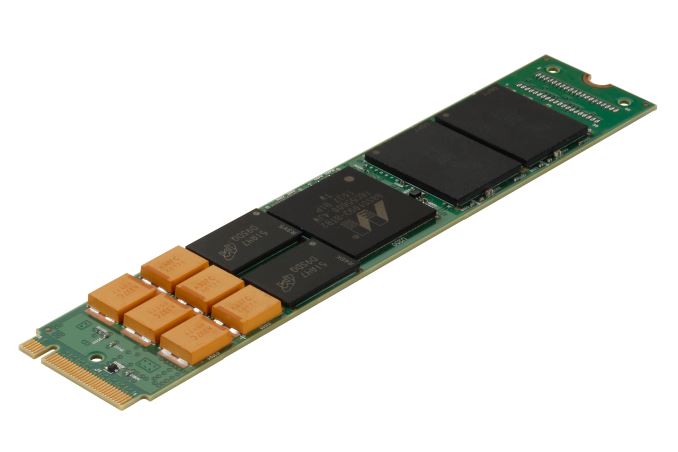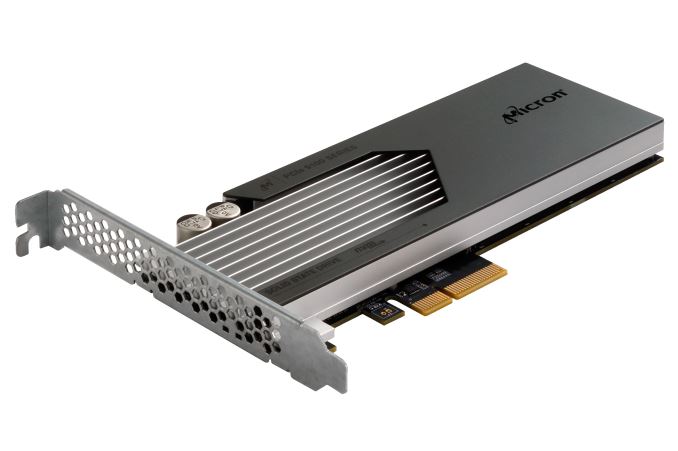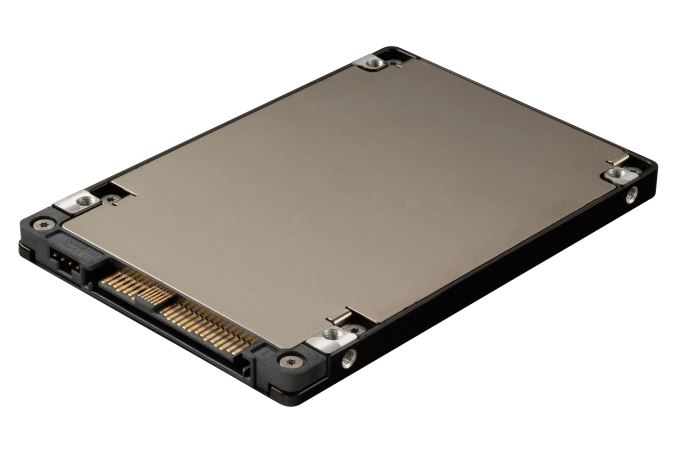Micron Announces 9100 & 7100 Series PCIe Enterprise SSDs
by Billy Tallis on April 12, 2016 11:30 AM EST- Posted in
- SSDs
- Storage
- Micron
- Enterprise SSDs
- NVMe

Micron entered the PCIe SSD market in 2011 with the formidable P320h. Using generously overprovisioned 34nm SLC NAND and a controller with 32 NAND channels and a PCIe 2.0 x8 link, the P320h boasted extreme write endurance ratings and performance that is still respectable by today's standards, but with a commensurate price tag. Two years later Micron introduced the P420m with the same controller but 25nm MLC NAND, adding power loss protection capacitors and offering similar performance on read-heavy workloads at a much more accessible price. Today Micron is announcing two new product lines that bring support for NVMe and PCIe 3.0 and use Micron's latest 16nm MLC NAND.
The new Micron 9100 NVMe PCIe SSD series is the high-performance and high-capacity product. Capacity ranges from 800GB to 3.2TB in either half-height half-length add-in card form factor or as a 15mm thick 2.5" U.2 drive. With a TDP of up to 27W, the Micron 9100 SSD is the more direct successor to the P420m and is using a PMC-Sierra controller that is descended from the controller used in Micron's previous PCIe SSDs.
| Micron 9100 PCIe SSD Specifications | |||||
| Capacity | 800GB | 1.2TB | 1.6TB | 2.4TB | 3.2TB |
| Interface | PCIe 3.0 x4 HHHL or U.2 | ||||
| Sequential Read | 2.1 GB/s | 2.8 GB/s | 2.8 GB/s | 3.0 GB/s | 3.0 GB/s |
| Sequential Write | 650 MB/s | 1.3 GB/s | 1.3 GB/s | 2.0 GB/s | 2.0 GB/s |
| Random Read IOPS | 540k | 700k | 700k | 750k | 750k |
| Random Write IOPS | 55k | 180k | 100k | 300k | 160k |
| Idle Power Consumption | 7W | ||||
| Active Power Consumption | 16W | 21W | 21W | 27W | 27W |
The Micron 7100 NVMe PCIe SSD expands Micron's offerings into a more mainstream segment of the market by adopting Marvell's 88SS1093 controller that is designed for client and smaller enterprise drives. Capacities for the 7100 range from 400GB to 960GB for the M.2 version and from 400GB to 1.9TB as a 7.5mm thick 2.5" U.2 drive. The smaller Marvell controller will keep power consumption below 12.5W and the M.2 version further throttles to a limit of 8.25W.
| Micron 7100 PCIe SSD Specifications | ||||||
| Capacity | 400GB | 480GB | 800GB | 960GB | 1.6TB | 1.92TB |
| Interface | M.2 22110 or 2.5" U.2 | 2.5" U.2 | ||||
| Sequential Read | 2.4 GB/s | 2.5 GB/s | 2.5 GB/s | |||
| Sequential Write | 475 MB/s (M.2) 500 MB/s (U.2) |
600 MB/s (M.2) 900 MB/s (U.2) |
900 MB/s | |||
| Random Read IOPS | 180k | 220k | 235k | |||
| Random Write IOPS | 25k | 10k | 33k | 12k | 40k | 15k |
| Idle Power Consumption | 3.7W | |||||
| Maximum Power Consumption | 8.25W (M.2) 12.5W (U.2) |
12.5W | ||||
Both the 9100 and 7100 series include models in two tiers of overprovisioning: for read-heavy or mixed workloads. The drives with greater overprivisioning sacrifice some capacity for greatly increased random write speeds and improved write endurance, though specifications for the latter have not yet been released.
Source: Micron












21 Comments
View All Comments
nils_ - Wednesday, April 20, 2016 - link
Whether it's labeled consumer, enthusiast, pro, datacenter or whatever the hell else, if data that is reported as flushed to the drive isn't actually there after power is lost and restored the product is flawed since it violates the standard. Imagine buying a car where the brakes only work 99.99% of the time on the cheaper models...easp - Tuesday, April 19, 2016 - link
Because it is still naive and foolish to think that BOM is or should be the main driver in the cost of a high tech product.As for why, its simple and obvious, and yet many people seem determined not to see it, so, I'll try a different way.
A good approach to optimize for a healthy profit margin AND a low BOM is to drive for economies of scale. Fixed costs can be amortized over more units and larger volumes also improve negotiating positions with suppliers.
A proven strategy for this is to design a product portfolio consisting of multiple product lines with multiple models, rather than a single product. Products across the portfolio share a lot of common designs, code and components. They are differentiated from each other by small differences in components, and larger differences in price points (and profit margins).
For some reason, this approach outrages a lot of people because they think they are being cheated out of the lowest price and maximum capability, not realizing that its quite likely that this approach means that they are getting more value at just about every price point than they would be if companies didn't engineer their product lines this way.
Instead of everyone winning though, they still would prefer a situation where everyone is worse off, themselves included. That seems to be the very definition of stupidity.
theeldest - Tuesday, April 12, 2016 - link
Yes, Surface Mount capacitors to provide power-loss protection.DanNeely - Tuesday, April 12, 2016 - link
That's exactly what they are/extide - Tuesday, April 12, 2016 - link
Yep, those are Tantalum Surface Mount Capacitorsplopke - Tuesday, April 12, 2016 - link
Speaking off micron , weren't we supposed to start seeing their 3D-Nand 2Q 2016 consumer products and maby enterprise 3D Xpoint products? Those press annoucement were early 2015? Are they already beeing used in products ? Only thing i find when i google is old press announcements.ant6n - Tuesday, April 12, 2016 - link
I thought there were supposed to have some big event today, there were rumors they'd make an announcement re 3d xpoint.vFunct - Tuesday, April 12, 2016 - link
What Queue depths were the Random Read & Write IOPS measured?Billy Tallis - Tuesday, April 12, 2016 - link
The spec sheet doesn't list queue depth, but does say that the figures are for steady-state performance.extide - Tuesday, April 12, 2016 - link
Given that these are enterprise drives, typical use would have them in queue depths >0-1 most of the time, so they are probably benched with fairly high queue depths.